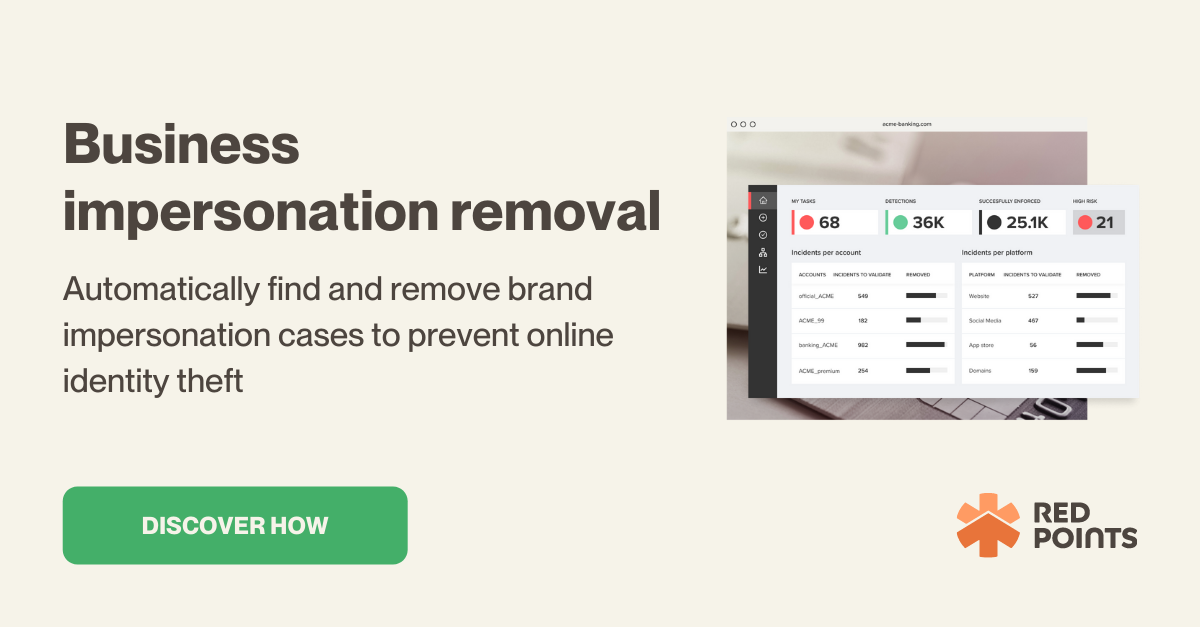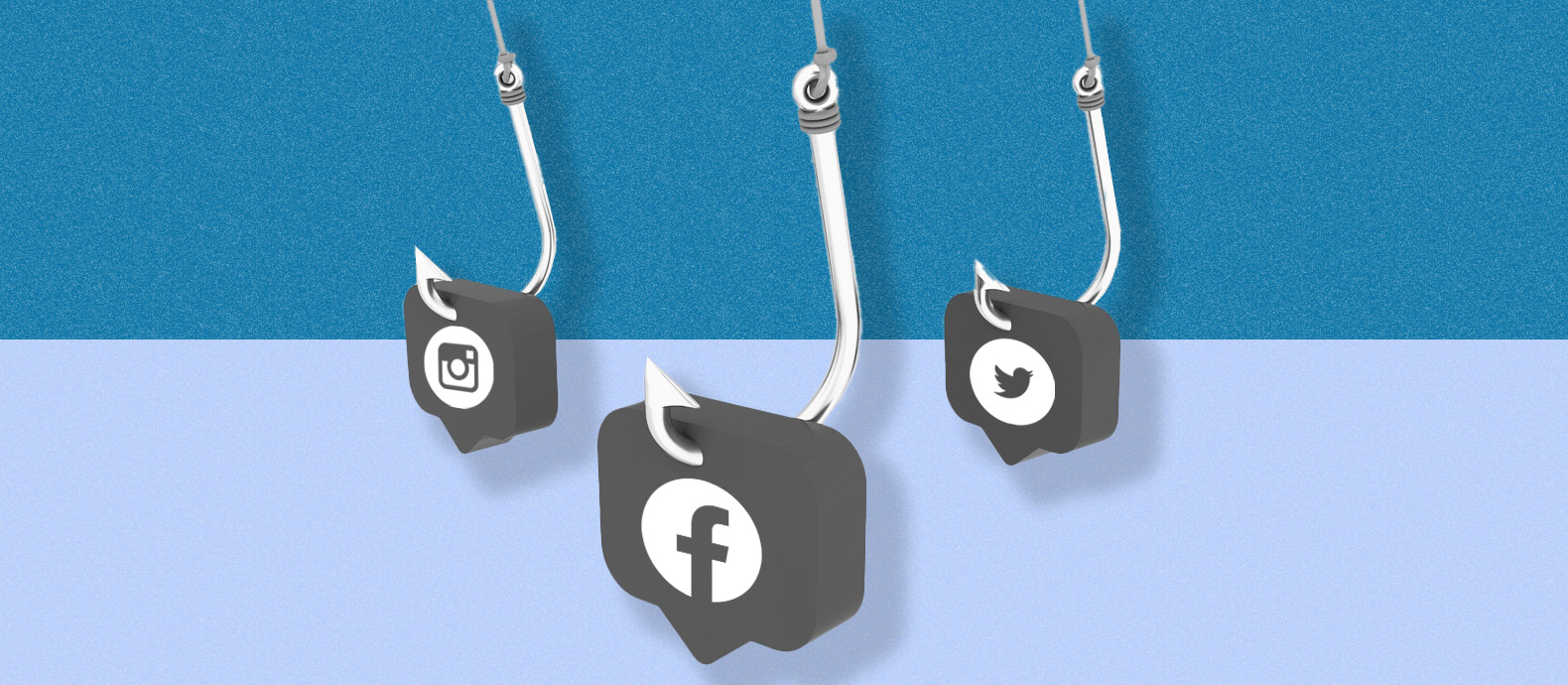Nowadays, virtually everyone is using social media, making social networks a new ground zero for cybercrime.
According to the Federal Trade Commission, social media fraud represented 26% of all losses last year, $770 million in total.
Not only is the increase in quantity alarming, but cybercriminals are also getting more sophisticated in using varying techniques and methodologies to launch social media fraud and scams.
This means that protecting your business from these social media frauds will be even more challenging, and you’ll need to put in more effort, time, and resources if you really want to succeed.
In this article, we will discuss all you need to know about how to protect your business and stop social media fraud, and by the end of this guide, you’d have learned about:
- How social media fraud affects businesses
- Common types of social media frauds and how to recognize them
- How to stop cybercriminals from impersonating your brandHow to prevent your employees from being scammed on social media
And more.
How social media fraud affects businesses
The most common and dangerous social media fraud scenario for businesses is when they are impersonated by bad actors as a part of the social media fraud scheme.
For example, a scammer may create a fraudulent account impersonating your brand on Instagram and then use the account to scam people who are interested in your brand, potentially including your prospects and customers.
This brand impersonation can significantly hurt your business’s reputation and revenue, and the damage can be long-term and even permanent when not managed properly.
As the old saying goes: trust can take years and even decades to build and yet only seconds to destroy. Damage to your reputation due to social media fraud may result in loss of partnerships and sponsorships, loyal customers, and, ultimately, revenue.
How bad actors monetize social media impersonation
The basic form of social media impersonation involves a bad actor creating one or more fake social media accounts on relevant social networks. They will use your brand’s distinguishable information (i.e., phone number, office address, etc.,) brand elements (logo, website URL, color palette), and content (photos, videos) to trick your audience into thinking that they are interacting with your brand’s legitimate social media accounts.
Once they’ve successfully attracted your audience and/or followers to this fake page, they can then launch the second phase of the attack, which can come in various different forms:
- Phishing/social engineering: tricking your customers into divulging their sensitive information (personally identifiable information, banking details, account credentials, etc.) For example, the fake social account may have a link pointing to a fake login page, tricking visitors into entering their credentials.
- Selling counterfeited goods: the fake social media account may attempt to deceive consumers by selling counterfeited or non-existent products. Typically the account will advertise a high-demand product or service at a discounted price to attract potential victims.
- Scams: bad actors may use fake social media accounts to launch various forms of scams (i.e., fake coupons and giveaways) in combination with phishing or fake ecommerce attacks.
The anatomy of social media impersonation
Impersonators may use various techniques and methodologies in performing social media impersonation fraud.
However, most social media impersonation frauds involve these characteristics:
- Impersonators often use the same information and content as the official social account (brand name, logo, photos, descriptions, hashtags, etc.) A typical methodology is to impersonate “customer service” or “technical support” pages rather than the main page of the brand. Or the page may focus on running giveaways and raffles.
- These fake pages may not solely rely on posts or stories but may send private messages to potential followers or run paid ad campaigns to attract visitors.
- Brands that do not have official accounts are often an easy target for this type of attack, but on the other side of the spectrum, impersonators may also target established brand accounts with large followers since they know there is a large potential audience to defraud.
- Impersonators may tailor their attack according to the type of social platform and/or audience targeted in the attack. For example, when launching impersonation attacks on LinkedIn, the impersonator may attempt to impersonate executives rather than brands, while on Instagram, impersonations are commonly done through Business Accounts. To accurately identify social media impersonations, it’s important to understand the nuances surrounding each platform and the brand’s target audience.
- In some social platforms, newly created accounts or pages can take up to several days to appear in search results. Impersonators may leverage these periods (when they are less likely to be found out) to launch aggressive scams, for example via aggressive ad campaigns to attract potential visitors.

How to protect your business from social media frauds
Since most social media fraud techniques are based on social engineering methodologies (i.e., phishing), the most important foundation in preventing social media frauds from affecting your company is to prepare employees, customers, and anyone with access to your company’s information accordingly.
Here are some actionable steps you can take:
1. Register your intellectual property (IP)
Having a strong intellectual property portfolio will make removing infringing posts and accounts much simpler, as most platforms require attaching evidence of trademark, copyright or patent registration.
Domestically, it’s important to register for intellectual property rights. But you also need to register for IP rights in China even if you have no intention of selling in China. Counterfeiters are able to copy product designs simply from seeing photos.
2. Educate and train employees
It’s very important to make sure your employees have adequate cybersecurity training so they can:
- Recognize various techniques of phishing and social media frauds
- Take the necessary step to prevent or mitigate the damage.
- Report the attempt so others in the team can be aware of it.
It’s crucial to consider that fraudsters regularly evolve their techniques and methodologies, so the training program should be comprehensive and updated regularly to include the newest methodologies and trends.
It’s recommended to make phishing, fraud, and cybersecurity training a mandatory part of your employee onboarding program.
3. Block malicious websites and apps from your company network
While this technique won’t be effective for phishing attempts involving brand new websites or apps, it’s still important to block known IPs, websites, and apps on your network.
You can also implement ACL (Access Control List) on your routing or security device and configure it accordingly to control which users can access and use certain files, which can also be effective in mitigating the damage of successful phishing attacks.
4. Require two-factor authentication
Two-factor authentication (2FA) or multi-factor authentication (MFA) is essentially asking for a secondary (or more) piece of information besides your password before you can log in to an account.
This information can be:
- Something you are: biometric ID like face ID, fingerprint, retinal scan
- Something you know: a secondary password, PIN, answer to security questions, and so on.
- Something you have: a device to pair with (i.e., a smartphone), a dongle, a keycard, and so on.
With 2FA or MFA in place, in the event of successful phishing attempts when an employee’s credential is compromised, the attacker still won’t be able to access the account without the second (or more) factor of information, adding an extra layer of security to protect your company’s sensitive information.
5. Maintain a regular backup schedule
Successful phishing attacks may not only result in data breaches but also malware infections and other damages.
During ransomware infection, for example, you may be locked out of essential files and apps, impacting your day-to-day operations.
To prevent this issue, it’s best to establish a regular and complete backup schedule, ideally with the 3-2-1 principles:
- Three copies of data backups
- Two different storage mediums
- One backup stored offsite
Protecting your brand from impersonation on social media
Unfortunately, creating a fake social media account impersonating your brand is very easy and affordable for scammers, much easier than building a fake website with a squatted domain name.
To combat these bad actors, we have gathered three key preventative measures:
- Making it as difficult as possible for scammers to impersonate your brand while making it as easy as possible for your target audience to recognize your legitimate account.
- Quickly detect any impersonation attempts while avoiding false positives and false negatives.
- Taking down fake accounts through appropriate means.
Here are the steps you can take:
1. Establish a strong social media presence and branding
The idea is that by having strong social branding on social media, it’s easier for your target audience to differentiate your legitimate profile from impersonating ones.
While social media branding and presence can be a pretty deep subject on its own, here are some general tips you can follow:
- Get verified (blue tick on Instagram, white checkmark on Twitter, etc.) If you are an established brand, the process should be relatively easy, and you can follow the guidelines provided on each platform.
- Have an established brand voice and tone down to the smallest details: catchphrases, traits, vocabulary, and so on. There are many guides for this, and Mailchimp’s style guide is a good place to start.
- Have a strong and consistent visual brand: logo, fonts, brand color schemes, etc., across social media networks. Write out comprehensive visual guidelines so your whole team can be consistent in its implementations.
- Use high-quality photos and videos. High-quality assets are difficult to impersonate and can also help with your credibility. However, make sure it’s aligned with your brand’s overall aesthetics.
Focus on being unique and recognizable to make it difficult for anyone to impersonate your brand.
2. Establish a monitoring and detection system
Since 100% prevention of brand impersonation is virtually impossible, early detection is a crucial step in maintaining your brand’s positive reputation against these impersonators.
Red Points’ Social Media Protection Software can help protect your brand at scale from cybersquatting in three steps:
- Real-time detection of social media impersonation by scouring the search engines, domain databases, and social networks.
- Reporting the fake social media account and requesting for takedown by automatically contacting social media platforms while providing adequate proof.
- Stopping repeat perpetrators by uncovering their identity and collecting data that may be required to take legal actions.
3. Enforcement and takedown
Once you’ve identified the fake social media accounts impersonating your brand, it’s important to take action as fast as possible.
Remember that leaving these accounts as they are for another day means another opportunity for them to damage your reputation and brand image.
Below are our detailed guides on how to enforce impersonations on different social media platforms on your own:
- Taking down a fake website and/or with cyber squatted domain name
- Taking down fake Instagram accounts impersonating your brand
- Report a fake Facebook business page
- Report a Twitter account for impersonation
What’s next
Social media frauds and scammers are on the rise, and the future isn’t really that promising either. Cybercriminals and other social media fraudsters only have one realistic solution: steer your brand away from them, and implement more sophisticated security measures to prevent them, along with a Social Media Monitoring Service.
With the tips explained above, you’ll guide your business through the murky waters of social media while protecting it from fraud attacks.







